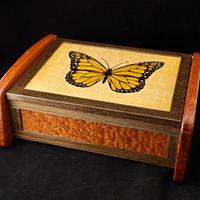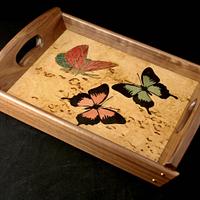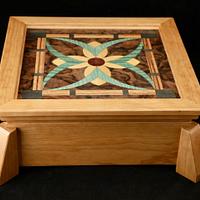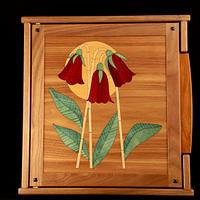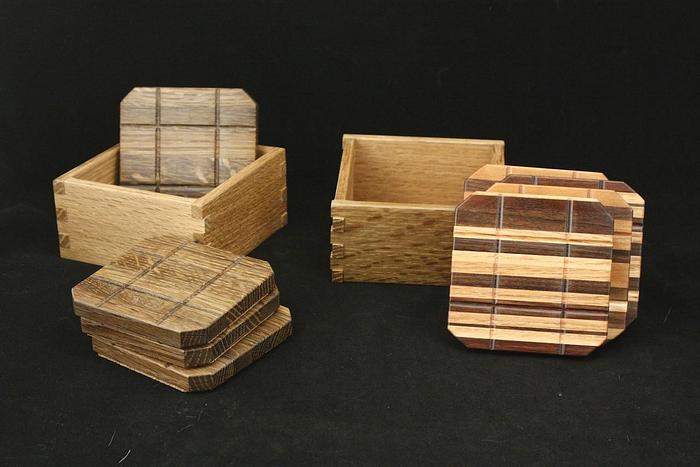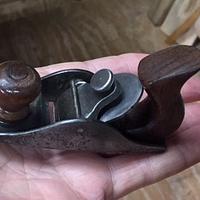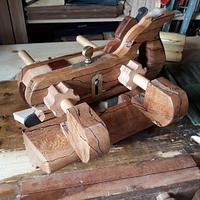
SplinterGroup
in about 3 years
More from SplinterGroup
Coasters
The coasters themselves are the same as previously made, about 3-3/4" square and 7/16" thick. Self adhesive cork pad for below and grooved top to break any beer can sweat grip.
I went with finger jointed holders since I had a stack of thin red oak left over form another project. Cutting the fingers on 13 copies actually went quick, only a few hours to whack them out since I had a jig for my miter and box joint blade set from previous happenings.
.jpeg)
The coasters were made from cutoffs, breadboard style, which actually is more work than using full boards.
They all need to have flat sides and be tall enough to get several coasters after laminating.
I managed to get 30 coasters of the white oak (left side of photo) and 12 of the walnut/cherry/white oak on the right. so 10 sets.
There is a thin plywood panel in the bottom with a finger hole to push coasters up and out. I thought about cutouts on the sides but too much work for what I sell these for.
Only the white oak coasters were fumed to get darkish, then I tried something different.
Coasters should be sealed to prevent moisture seeping in and ruining them and any finish should not peel/flake off.
For the first problem, sealing. I previously used Cactus Juice resin in a vacuum pot, The coasters were glued together with TB3
which has a max temperature of 200F. The CJ resin needs to be cooked for several hours at 200F. I was able to do this but with the $$ of the CJ and limited life, it wasn't economical to use though it did make the coasters impervious.
This time I thought I'd try polyurethane thinned 50% with mineral spirits.
I could let the vacuum pot do its work while I got onto other stuff. After removal from the pot, I would let them air dry for a day then force out any remaining MS using my old school food dehydrator at 125F for a day. Seemed to do its job, no seepage or odor. All 42 coasters used 1/2 quart poly + 1/2 quart MS. I even repeated the process for a second soak to be sure.
I have a few spare coasters to use at home for evaluation.
No top coat needed so the second problem of finish flaking is also (potentially) solved.
If you fume white oak with a long soaking , it can come out almost black. Sand the surface to re-expose the flecks and the quarter sawn can really pop.
.jpeg)
21 Comments
working with my hands is a joy,it gives me a sense of fulfillment,somthing so many seek and so few find.-SAM MALOOF.
Mike
It's a chore to keep the gallery shelves filled, eats up all my spare shop time but I need to keep it going to cover the booth rentals and if the gallery shuts down, I'd have no other place to sell stuff.
At least with the gallery, I don't worry about selling, I just build. I've been sneaking up the prices to be sure I at least break even at the end of the year. Best year ever I made a profit of about $300 🤠😬🤫
Ron
daveg, SW Washington & AZ
David
Ryan/// ~sigh~ I blew up another bowl. Moke told me "I made the inside bigger than the outside".
working with my hands is a joy,it gives me a sense of fulfillment,somthing so many seek and so few find.-SAM MALOOF.
Probably plenty of local upscale places to place a commission or two. Just don't turn it into a business 🤠
working with my hands is a joy,it gives me a sense of fulfillment,somthing so many seek and so few find.-SAM MALOOF.
No name noobie here
*TONY ** Denver * ALWAYS REMEMBER TO HAVE FUN
Funny YRTi 🤠 I wonder if sake would taste as good out of a red oak, polyurethane coated box?
The grooved top came about from my sweaty beer can always sticking, then dropping the coaster in my lap with every sip. Annoyance is the mother of invention!
"Duck and Bob would be out doin some farming with funny hats on." chrisstef
I just bought the set and I love it.
Also thanks for the info on sanding back fumed white oak to pop the flecks, I never tried that.
.................. John D....................
BJ blade set is sooo useful.
I have been commenting on the beer and glass sweating problem for years with flat coasters. The somewhat decorative grooves solves that problem.
I see one more thing I might change. Add a slot down one side of the box so the coasters can be picked out without dumping the entire box. But, that is just one more step that takes time in the construction.









